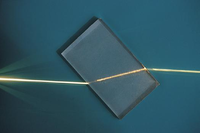
Photo from wikipedia
Abstract In this paper, we introduce a new thin-film polarizing beam splitter (PBS) based on air as a layer with a low refractive index (L) and titanium dioxide (TiO2) as… Click to show full abstract
Abstract In this paper, we introduce a new thin-film polarizing beam splitter (PBS) based on air as a layer with a low refractive index (L) and titanium dioxide (TiO2) as a material with a high refractive index (H). A cube-type PBS presents an active area of approximately 1.0 × 1.0 mm2, and the airgap layer in conjunction with TiO2 thin-films provides an extremely high refractive index contrast (1.2). The PBS cube is projected onto a borosilicate glass substrate and the multiple layers obtained through TFCalcTM simulations, expressed in multiples of a quarter-wavelength optical thickness, are 1.6H L 1.1H 1.5L 1.1H L 1.6H. The projected structure ensures the separation of the polarizing states of light (transmission of the p-polarization and reflection of the s-polarization) from the visible to near infrared spectral range, over a bandwidth higher than 170 nm. This is the minimal working bandwidth obtained for visible range (centered at 550 nm), considering a polarization degree higher than 0.95. The projected PBS is fabricated based on conventional microelectromechanical systems (MEMS) technologies, namely, thin-film deposition, annealing, and etching processes. Finally, the fabricated PBS was experimentally characterized, with the measured transmittance of the fabricated structure reaching close to the expected TFCalcTM simulation result. This characterization is the final validation of the structure since, theoretically, reflection is the complement of transmission in a dielectric thin-film multilayer.
Journal Title: Optics and Lasers in Engineering
Year Published: 2020
Link to full text (if available)
Share on Social Media: Sign Up to like & get
recommendations!